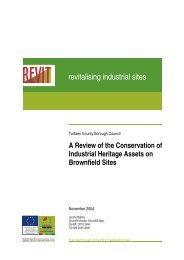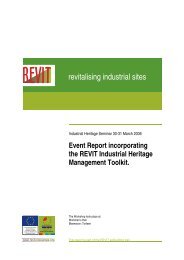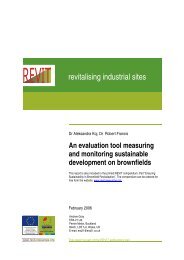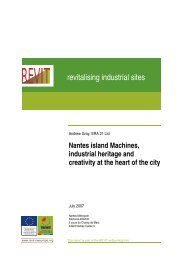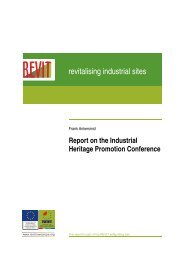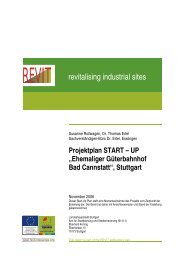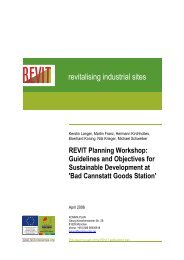Review of Sustainable Brownfield Revitalisation Approaches.pdf
Review of Sustainable Brownfield Revitalisation Approaches.pdf
Review of Sustainable Brownfield Revitalisation Approaches.pdf
Create successful ePaper yourself
Turn your PDF publications into a flip-book with our unique Google optimized e-Paper software.
Torfaen County Borough Council<br />
A <strong>Review</strong> <strong>of</strong> <strong>Sustainable</strong> <strong>Brownfield</strong> <strong>Revitalisation</strong> <strong>Approaches</strong><br />
6.1.19 The act defines contaminated land as "any land which appears to the local<br />
authority in whose area it is situated to be in such a condition, by reason <strong>of</strong><br />
substances in, on or under the land, that:<br />
6.1.20 Under the act there are four possible grounds for determination <strong>of</strong> land as<br />
Contaminated Land, namely that:<br />
• Significant harm is being caused.<br />
• There is significant possibility that significant harm is being caused.<br />
• Pollution <strong>of</strong> controlled waters is being caused; or<br />
• Pollution <strong>of</strong> controlled waters is likely to be caused.<br />
6.1.21 The EPA (1990) came into force in Wales in July 2001 via the Contaminated<br />
Land (Wales) Regulations 2000, introducing a new regulatory regime for the<br />
identification and remediation <strong>of</strong> contaminated land.<br />
6.1.22 Vacant land is a further category which can be described as land on which<br />
some previous productive use has ceased for a significant period <strong>of</strong> time and<br />
also land which would benefit from development or improvement.<br />
6.2 Legal Framework<br />
6.2.1 The main legal control on any development is the system <strong>of</strong> land-use planning<br />
set out in the Town and Country Planning Act 1990. Any development requires<br />
specific “planning permission”, which may control not only the location <strong>of</strong><br />
development, but also the nature <strong>of</strong> that development and the way it is carried<br />
out. Specifically in the context <strong>of</strong> <strong>Brownfield</strong> redevelopment, the planning<br />
permission may contain specific conditions relating to site investigation and<br />
assessment and, where appropriate, remediation <strong>of</strong> contamination. Guidance<br />
to planning authorities on “contaminated land” aspects <strong>of</strong> planning is set out in<br />
Planning Policy Guidance note PPG 23.<br />
6.2.2 It should be noted that Planning Policy Guidance Notes (PPGs) are shortly to<br />
be replaced by Planning Policy Statements in England and by the Planning<br />
Policy Wales and TANs is Wales.<br />
6.2.3 Planning and Pollution Control (DOE, 1994 as cited in Grimski and Ferber,<br />
2002).This guidance is being revised, with a view to the publication <strong>of</strong> specific<br />
planning guidance on developments on land which may be affected by<br />
contamination. The status <strong>of</strong> this review is not known at the time <strong>of</strong> writing.<br />
<strong>Brownfield</strong> redevelopment projects above a certain size also require<br />
environmental impact assessments as part <strong>of</strong> the planning approval process.<br />
6.2.4 In addition, the Building Regulations impose a system <strong>of</strong> controls over the<br />
details <strong>of</strong> construction <strong>of</strong> any building. These cover a range <strong>of</strong> issues from the<br />
integrity <strong>of</strong> the foundations, through to issues such as disabled access to<br />
public buildings. They include specific requirements to ensure that buildings<br />
and building services are protected from the effects <strong>of</strong> any contaminants in the<br />
ground under the building.<br />
6.2.5 Land remediation activities may need prior regulatory approval under the<br />
waste management licensing system under Part II <strong>of</strong> the Environmental<br />
Protection Act 1990 (which implements the European Waste Framework<br />
Directive) or the system <strong>of</strong> Integrated Pollution Prevention and Control (which<br />
implements the directive <strong>of</strong> the same name). Some remediation processes are<br />
defined (under the Directive) as “waste disposal” or “waste recovery”<br />
0014021/R01 19 Fehler! Formatvorlage nicht definiert.



